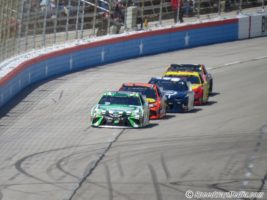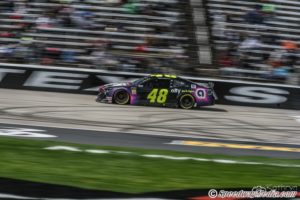Race No. 7 of the 2019 Monster Energy NASCAR Cup Series season is in the books, and I have some thoughts to share with the class.
The race

If you follow me on Twitter, you know my thoughts on races at Texas Motor Speedway already. For those who don’t, I’m not a fan of the racing at Texas. For years, it’s been unwatchable, single-file snore-fests. And the fact that both races at Texas are 500 miles in length made boring races there more agonizing to watch.
Maybe it was my low expectations for races at Texas, but Sunday’s O’Reilly Auto Parts 500 was good.
The field didn’t get exponentially stretched out as the race progressed, and the leader didn’t simply pull away from the car in second.
It was the race that I thought we’d get at Las Vegas Motor Speedway a few weeks ago.
With that said, however, there was still the ever present fact that passing the leader was a Herculean task. Yes, the number of lead changes were up from 2018 (26 among 13 different drivers in 2019 vs. 16 among eight different drivers in 2018), but by my count, only five of them happened on track under green. The rest were a result of pit stops, which tends to inflate the number of lead changes.
It was more of the varying pit stop mistakes and cycles that made the race compelling to watch. Last season, races at Chicagoland Speedway, Las Vegas in September and Homestead were great races, because of the racing product, not pit road mistakes.
Which is why I don’t believe this high downforce package is the right direction for the sport.
Yes, it was entertaining, but it was in spite of the racing on track, not because of it.
Compare it to the Bahrain Grand Prix earlier in the day. It had a great mix of pit stop strategy and on track competition that made it legitimately good racing.
I know that “we’re in the entertainment business,” but I believe that NASCAR should treat its events as a sports competition first.
Jimmie Johnson’s afternoon

In 2018, Jimmie Johnson led a grand total of 40 laps, and didn’t lead more than 13 in one race. On Sunday, he led 60 laps, 150 percent more than he did in 2018.
And while he didn’t lead a second time in the race, he maintained the second-highest running average all race at 7.78.
Johnson had a race that was a step in the right direction. His car was great in clean air and had speed.
“It was a little evil in traffic, and I had a heck of a time on green flag restarts, but really worked hard to get it up underneath me and tightening the car up a little bit for us to race,” he said. “Ended up having great pace and decent drivability, so are working in the right direction.”
For the first time in quite a long time, Johnson was a legitimate threat to win, and at a mile and a half track.
If he continues this at Kansas Speedway in a few weeks, we can truly say he’s back.
Qualifying
Let’s just get something out of the way. NASCAR brought this on itself.
If you missed qualifying Friday, there were multiple instances of drivers blatantly violating NASCAR’s new impeding rule. Most egregious was Ryan Newman and Clint Bowyer.
And what did NASCAR do? They did nothing. All they had to do was enforce the rule they put in place, and we’re not talking about this.
And now, we’re seriously discussing the possibility of returning to single-car qualifying for
This same thing happened with the restart zone four years ago and the overtime line two years ago.
NASCAR, if you want these games to stop, enforce the rules you put in place, unless you want the inmates to continue running the asylum. If not, don’t have these rules in place.
That’s my view, for what it’s worth.







